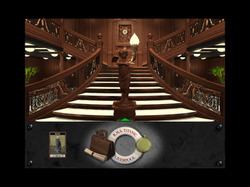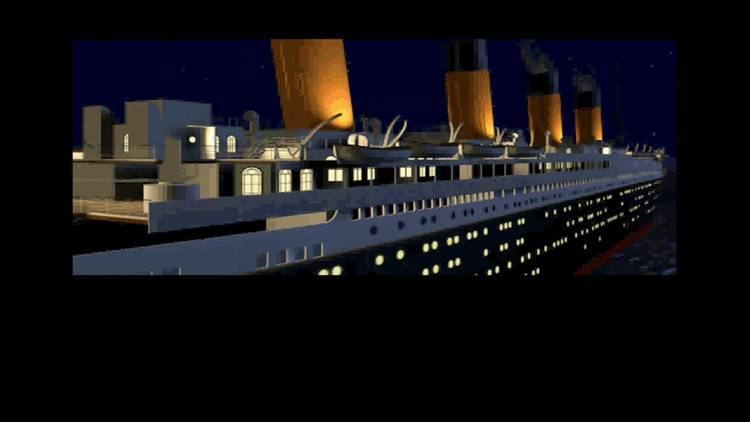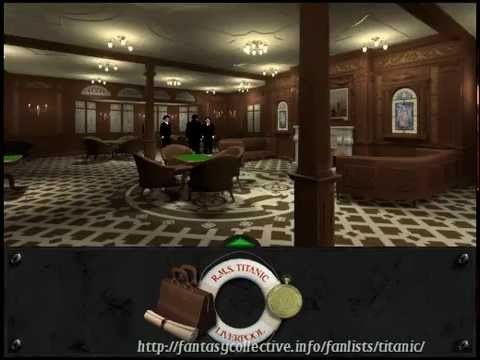9 /10 1 Votes
Designer(s) Bob Clouse Composer(s) Erik Holt Initial release date 1996 Producer Andrew Nelson | 4.5/5 My Abandonware Writer(s) Andrew Nelson Engine DreamFactory Developer CyberFlix Mode Single-player video game | |||||||||||||||||||||||||||||||||
Programmer(s) Bill Appleton
Todd Appleton Genre(s) Point-and-click adventure Platforms Microsoft Windows, Macintosh operating systems Publishers Europress, Bandai, GTE Interactive Media, Bomico Entertainment Software GmbH, Media Kite, Atari Europe S.A.S.U. Similar CyberFlix games, Adventure games | ||||||||||||||||||||||||||||||||||
Titanic adventure out of time pc game review
Titanic: Adventure Out of Time is a point-and-click adventure game developed by CyberFlix and published in the United States and United Kingdom by GTE Entertainment and Europress respectively, for Microsoft Windows and Macintosh, in 1996. It takes place in a virtual representation of the RMS Titanic. The player assumes the role of a former British spy who, during the London Blitz, is sent back in time to the Titanic and must complete a previously failed mission to prevent World War I, the Russian Revolution, and World War II. The gameplay involves exploring the ship and solving puzzles. There are multiple outcomes and endings to the game depending on the player's interaction with characters and use of items.
Contents
- Titanic adventure out of time pc game review
- Titanic adventure out of time perfect ending full playthrough
- Gameplay
- Plot
- Development
- Music
- Reception and legacy
- References
The game was created with CyberFlix's proprietary engine DreamFactory, which was also used to create Dust: A Tale of the Wired West. Extensive research was done by the development team to ensure historical accuracy and to precisely recreate the ship's interior and exterior 3D environments. As with Dust, Titanic's character animation was done by overlaying multiple still photos of actors to create mouth and facial movements. Titanic was commercially successful and received generally positive reviews from gaming critics, who praised the game's story, atmosphere and recreation of the ship, but criticized the character animation and some of the puzzles.
Titanic adventure out of time perfect ending full playthrough
Gameplay

Titanic: Adventure Out of Time is an adventure game played from a first-person perspective with a point-and-click interface in which players roam a fully rendered model of the RMS Titanic. The game's control scheme is composed of a keyboard, whose arrow keys control the player's movements, and a mouse, with which the player can interact with objects, characters, select dialogue and options from the HUD interface; these are a lifesaver (which brings the player to the options menu), an inventory bag and a pocket watch that indicates the game's progression.

The puzzles in Titanic rely on collecting and using certain items to advance the story. Dialogue is also a significant aspect of the game. Characters are programmed to remember the player's actions and react accordingly, and thus the choice of dialogue options deeply influences the story's outcome as to what items the player can acquire or the tasks she or he is able to complete. As a result, the game can have a total of eight distinct endings, not all of which present success in the mission.

Time is another important aspect of the game. The story does not occur in real time, with time progressing only if certain tasks and puzzles are completed, as indicated by the aforementioned pocket watch; however, as soon as the player reaches the point in which the Titanic starts sinking, the game progresses in real time, and the player is thus given a time limit to complete the game. As mentioned above, there are multiple endings for the game's completion, some of which result in death.

In addition to the main story, the game also includes a "ship's tour" game mode which features characters in the game narrating certain aspects of the ship, its crew and passengers, and the sinking. These characters can be found in different locations in the ship. Three of the character narrations were already included with the game, while others could be downloaded from CyberFlix's official website.
Plot
Players assume the role of Frank Carlson, a former British secret agent who failed a mission aboard the RMS Titanic. On 14 April 1942, Carlson is caught in an air raid during the London Blitz and is sent back in time to the ship on the night it sank, having a second chance to complete his mission.
Carlson's first mission is to locate and retrieve a stolen copy of Omar Khayyam's Rubáiyát, suspected of being in the possession of German Colonel Zeitel, who is traveling to New York to inspect embassies in the United States and Central America, alongside his young protegé Willi Von Haderlitz. It is revealed that the Colonel has made a deal with art dealer Sasha Barbicon to exchange the Rubáiyát for a painting in which there are hidden war plans stolen from the British government. They each act through a go-between, the Serbian stowaway Vlad Demonic. In addition to the Rubáiyát and the painting, the player learns that Willi is a spy for the Russians and has a notebook with names of top Bolshevik leaders. The notebook must be handed over to the Ochrana so that Communist rebels will be executed, preventing a threat to the Czar. Barbicon is also in possession of a stolen diamond necklace intended to finance the Black Hand, a Serbian military group. Assisting the player is fellow agent Penny Pringle.
The player can also become involved in optional subplots that do not pertain to the central mission or the winning conditions of the game. The main subplot involves retrieving a business document stolen by steel magnate Andrew Conkling's maid Shailagh Hacker. Others involve helping passengers such as the Lambeths, a wealthy couple whose marriage has deteriorated; Leyland Trask, a psychic from Boston; Reverend Edgar Troutt, a Protestant preacher from New Hampshire who is returning from a mission in Nyasaland; and Max Seidelmann, a businessman from Philadelphia.
The number of objects the player obtains before escaping the ship affects the ending and how history plays out. If the player manages to successfully obtain all four objects, history is altered with World War I, the Russian Revolution, and World War II never occurring.
Afterwards, the character retires after a successful career to a world of peace. Depending on which items the player fails to collect, history will change, but certain wars or revolutions will still occur.
Development
The concept for the game was created by writer and producer Andrew Nelson, who spent ten months working on the game's script, changing the plot and characters in accordance to the needs and demands of the project. CyberFlix's team spent two years researching to ensure the game would be authentic and historically accurate. Apollo 13 screenwriter William Broyles, Jr. served as a historical and photo researcher for the game, collaborating with CyberFlix in finding resources to faithfully re-create the ship and the period the game is set on. Broyles made an extensive use of the Internet and the Library of Congress's online photo department to find historical photos.
Todd Appleton served as lead programmer. The game was developed using CyberFlix's proprietary game engine and software DreamFactory, which was also used by the company to develop Dust: A Tale of the Wired West. The engine allowed the developers to create 3D environments and script the characters so that they retain memory of the player's actions and react differently each time they encounter the player. Wire-frame models of the Titanic, created by the Zygote Media Group in Utah, were textured and polished by graphical artists Michael Kennedy, Alex Tschetter and Paul Haskins. Bob Clouse and Billy Davenport were responsible for the 2D and interface design.
To create Titanic's character animation and movements, the developers cyberscaned multiple still photos of actors and overlayed them on the character's faces to create accurate facial and mouth movements. CyberFlix used the proprietary software HeadShop to combine photography and animation, as opposed to video, for the characters; according to Nelson, the team was not able to use QuickTime for the characters "as video takes up more disk space" and only a few characters could be created. The game's development took nineteen months, with CyberFlix finishing the game in November 1996. GTE Entertainment picked the game for release after Viacom turned it down.
Music
The soundtrack was composed by Erik Holt, with Scott Scheinbaum serving as musical director. Holt cited as inspirations Igor Stravinsky and Joe Satriani, and also studied composers that were popular in 1912, the game's time period, such as Chopin, Verdi, Rossini, and Mahler, to better evoke both the splendorous and melancholic atmosphere surrounding the Titanic's disaster.
Holt worked for three months on the game's core themes, mixing classical and early 20th-century music with elements of cinematic score. Aside from its original music, the game also features Chopin's Prelude Op. 28 No. 7, which plays on the radio in the opening scene.
Reception and legacy
Titanic: Adventure Out of Time was financially successful, selling over 100,000 copies in its first two months of release. After the release of James Cameron's successful Titanic in 1997, CyberFlix re-promoted its game and it went on to be one of the bestselling computer games of 1998. Reviews for the game were generally positive. Review aggregator GameRankings.com gives a score of 70% based on five reviews.
WorldVillage's Grace Smith gave Titanic a perfect score of 5/5 and lauded the game's 3D replica of the ship, plot, characters, gameplay and animation. In a review for Just Adventure, Michal Necasek rated Titanic B+ and praised the game's story and its nonlinearity, as well as the accurate reconstruction of the Titanic, saying that it "greatly adds to the atmosphere of [the game]". He also commended the music and voice acting, but criticized the action sequences. Tony Seideman of Computer Shopper overall praised the game but criticized some of the game's fictional elements and the lacking historical background provided by the Tour guide mode. GameSpot's Tim McDonald rated the game 6.6 /10, praising its re-creation of the ship and the story, but criticizing the long dialogue sequences and the lack of puzzles. Wojciech Kotas of MacGamer praised the game's plot, graphics and "immersive" gameplay, and called it "one of the better adventure games of 1996".
Adventure Gamers' Heidi Fournier rated the game a 3.5/5 and gave high praise to the exploration of the ship and the storyline, calling the subplots "engrossing", but offered minor criticism regarding some of the puzzles, calling them easy, and the characters' movements. In a 2014 retrospective review of the game, PC Gamer's Richard Cobbett compared it to The Last Express, finding similarities between plot elements, gameplay and calling it its "spiritual cousin". Cobbett overall praised the game, stating that it is an inspired take on the Titanic story that treats it respectfully "while still spinning off into cool new directions." In a mixed review, Game Revolution lauded the graphics and painstaking detail of the ship's reconstruction, but criticized the story and character animations, stating that Titanic offers "very little" as a game.
Adventure Gamers included the game in its list of the Top 100 All-Time Adventure Games, in the 100th position, praising the setting and the timed element as highlights. A full conversion of the game on Java was made available online by Daniel Hobi, and can be played on web browsers. Television documentaries on the Titanic and channels such as Discovery have used scenes from the game because of its faithful recreation of the ship.
